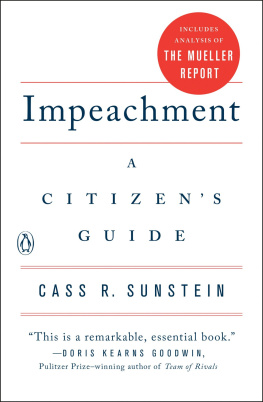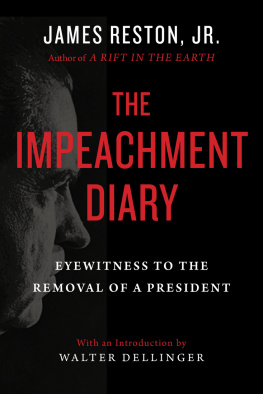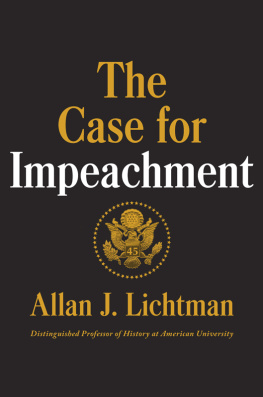Impeachment
IMPEACHMENT
A Handbook New Edition
CHARLES L. BLACK, JR.
PHILIP BOBBITT
Yale UNIVERSITY PRESS
NEW HAVEN & LONDON
copyright 1974 by Yale University.
Other material herein copyright 2018 by Philip Bobbitt.
All rights reserved.
This book may not be reproduced, in whole or in part, including illustrations, in any form (beyond that copying permitted by Sections 107 and 108 of the U.S. Copyright Law and except by reviewers for the public press), without written permission from the publishers.
Yale University Press books may be purchased in quantity for educational, business, or promotional use. For information, please e-mail (U.K. office).
Set in Minion type by Newgen North America.
Printed in the United States of America.
Library of Congress Control Number: 2018943233
ISBN 978-0-300-23826-6 (paperback : alk. paper)
A catalogue record for this book is available from the British Library.
This paper meets the requirements of ANSI/NISO Z39.48-1992 (Permanence of Paper).
10 9 8 7 6 5 4 3 2 1
To my sister,
Betty Black Hatchett
With much love
C.L.B., Jr.
To Pasha and Rebekah
For unto whomsoever much is given, of them shall be
much required; and from those who have been entrusted
with much, much more will be asked.
P.C.B.
Contents
Preface to the New Edition
It is said that in the United States, a new & improved label will always increase sales. This is doubtless a testament to our irrepressible optimism.
Since the publication of Impeachment: A Handbook, by Charles L. Black, Jr., in 1974, it has become the standard work. Lawfare called it the most important book ever written on presidential impeachment. Its sales peak whenever there is impeachment talk in the Congress, and staffers can be seen like schoolchildren carrying their vade mecums.
As the 2018 midterm elections approached, there was some anxietyand no doubt, in some quarters, hopethat impeachment might again be undertaken. As it happened, I was teaching the Handbook in my Legal Methods class at Columbia as an exquisite demonstration of the forms of constitutional argument. My students complained that the book had been published before any definitive action was taken to remove President Nixon, and they chafed to know how Black would have dealt with the significant questions of the hourboth then and now. Was the hacking of the Democratic campaign chairmans emails in 2016 like the burglary of the Democratic campaign chairmans correspondence at the Watergate complex in 1972? Was the Republican campaigns contacts with Russian diplomats in 2016 like the Nixon campaigns contacts with South Vietnamese diplomats in 1968? Do the House Judiciary Committees charges against Nixon set a precedent defining an impeachable offense arising from improper use of the Justice Department, even though the president resigned before the House could vote on this charge? Was the Clinton impeachment charge for the obstruction of justice a precedent because it was adopted by the Houseor not, because the Senate did not convict on this charge? And what about issues Black didnt address, like the relation between the Twenty-Fifth Amendment and impeachment, or the role of the Emoluments Clause as a possible basis for impeachment? And what about the presidents pardon power? Are there circumstances in which the issuance of a pardonor the promise of onecan provide a ground for impeachment?
To all of these questions, I gave the same answer: my students had all they needed in Blacks book. It wouldnt tell them what to think of these or any other problems, even in the Nixon case, which was unfolding as the book was written. The Handbook would instruct them how to think. It laid out clearly and concisely the methods by which a legal answer could be derived from the text, history, structure, doctrine, practicality, and ethos of the Constitution, and it showed rather elegantly how to apply these six fundamental methods.
Still, I took the students point. Blacks chapter Application to Particular Problems cried out for the application of his methods to the problems raised by the class. And there were important precedentscases of attempted and partly successful impeachments that created or affirmed doctrinethat had occurred since the books publication.
Moreover, while Blacks masterpiece remained the standard reference work, new books on presidential impeachment were appearing by writers I liked and respected that, because of their intrinsic merit and also because of the consumer bias for the new & improved, might eclipse the Handbook in the marketplace. That would be a great shame, not because there is anything wrong with these new books but because outside the esoteric topic of impeachment, Blacks book was a key exposition of how we go about resolving constitutional questions in the absence of a Supreme Court opinion. (This remains, I hate to say, a continuing problem for the field. When asked whether a president could pardon himself, a prominent law professor replied, There really is no answer to this question since it has never arisen.) Allowing Blacks book to gather dust on the library shelves would be far more than simply a loss for the literature on impeachment, which in any case would build on his insights. It would remove a foundation stone from the intellectual edifice that is perhaps the most important advance made in constitutional law during my lifetime: the development of what might be called the standard model that enables legislators, citizens, and journalists as well as judges to resolve constitutional questions when there is no authoritative judicial precedent, and to assess judicial opinions when there is a precedent. Blacks tour de force is as important to this development as Weinberg and Salams equations are to the Standard Model in physics.
The one thing I refused to do in this new edition was to touch a word of Blacks inimitable writing. It was enough that I was foolishly prepared to put my own stolid texts next to his poet-perfect prose. I would not revise Blacks work of genius.
So here it is: new (in some respects) but not improved.
Philip Bobbitt
March 18, 2018
Preface
My thanks go to Chester Kerr and to all at the Yale University Press, for extraordinary help and cooperationbut most especially to Jane Isay, the best of editors; to Margaret Abelson, for expert and most timely typing help; to Eileen Quinn, both for that and for valuable suggestions on the manuscript; to the staff of the Yale Law School Library; to Barbara Aronstein Black, for ideas developed in many discussions while the book was germinating, and for several crucial suggestions toward the end. On all public law matters, as in so many other ways, I have benefitted through the years from the works and friendship of Max Gluckman, whose constitutional studies of the Barotse, and of other societies remote from our own, have concentrated in great part on the eternal problems of removal and succession; luckily, he and Mary Gluckman have been in New Haven while this book was being written. I never can publish anything in constitutional law without acknowledging afresh my pervasive debt to Alexander Bickel, for what are now eighteen years of generously given access to his rich store of knowledge and thought.
Vade libelle!
C.L.B., Jr.
New Haven
May 21, 1974
PART I
Charles L. Black, Jr.
CHAPTER 1
Introduction
For the first time in more than a century, and for the second time in our history, the country has in 1974 been faced with the live possibility that a president may, in the words of the Constitution, be removed from Office on Impeachment for, and Conviction of, Treason, Bribery, or other high Crimes and Misdemeanors.
Next page






